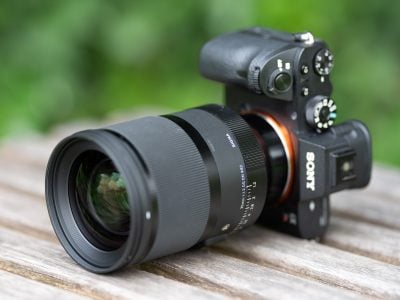Sigma 35mm f1.2 DG DN Art review
-
-
Written by Thomas
Intro
The Sigma 35mm f1.2 DG DN Art is a mild wide-angle lens designed for full-frame mirrorless cameras and available in the Sony E and Leica L mounts, the latter working on Leica, Panasonic and Sigma L-mount bodies. Announced in July 2019 alongside a 14-24mm f2.8 Art and 45mm f2.8 Contemporary (again in both Sony E and Leica L mounts), they’re Sigma’s first lenses designed from the ground-up for full-frame mirrorless cameras and not adapted from an earlier DSLR design.
The 35mm f1.2 joins Sigma’s celebrated Art series and is the company’s first lens with an f1.2 focal ratio, not to mention one of the only 35mm lenses from any company with an f1.2 focal ratio and autofocus. With its substantial front element, the Sigma 35mm f1.2 is an unsurprisingly large lens. It offers an aperture ring with 1/3 stop clicks which can be turned off for continuous, smooth, and noise-free operation. Plus it has a button which can be assigned various functions like AF-Lock. And you can get the mount changed between L-mount and E-mount (at a cost). This is a unique feature that no other manufacturer offers.
To find out how the Sigma 35mm f1.2 DG DN Art performs I tested it on the 42MP A7R II body and compared it to the Sony FE 35mm f1.4 ZA, Sony FE 35mm f1.8, and Samyang AF 35mm f1.4 FE. So if you’re looking for a mild wide-angle prime for your Sony mirrorless camera, you’ve come to the right place!
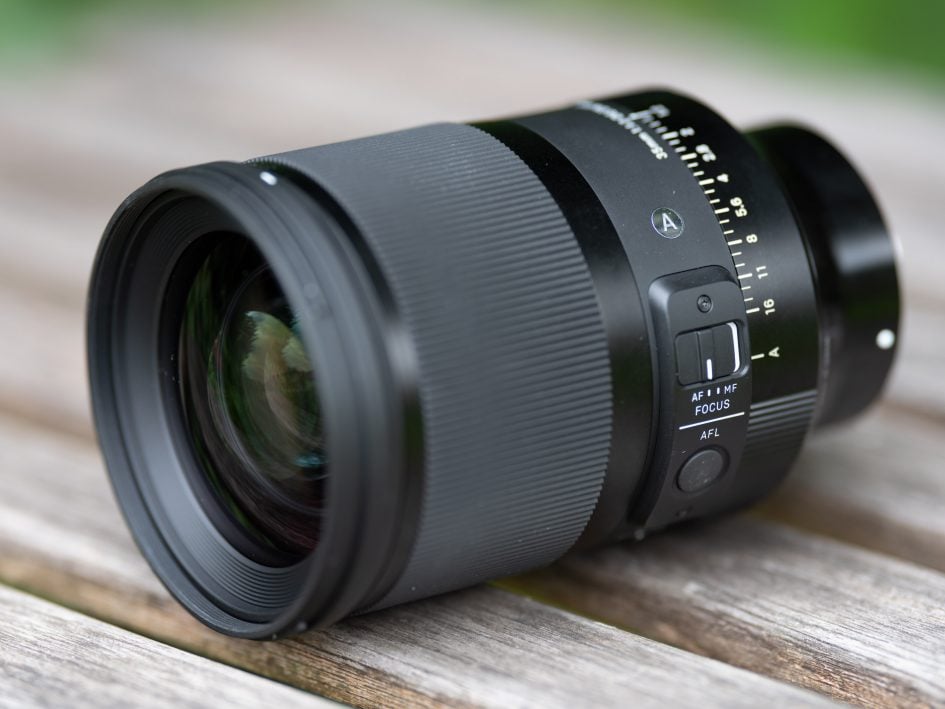
Facts from the catalog
As usual I’ll have a look at the technical data of the Sigma 35mm f1.2 DG DN Art first. I’ve rated the features with a [+] (or [++]), when it’s better than average or even state of the art, a [0] if it’s standard or just average, and [-] if there’s a disadvantage. For comparison I use the Sony FE 35mm f1.4 ZA, Sony FE 35mm f1.8 (“Sony f1.4” resp. “Sony f1.8” for short) plus the Samyang AF 35mm f1.4 FE (“Samyang”).
Size (diameter x length): At 88 x 137mm (3.5 x 5.4in.) plus 50mm for the lens hood (106mm diameter) the Sigma 35mm f1.2 DG DN Art is a huge lens. The Sony f1.4 is 79 x 112mm + 37mm lens hood, the Samyang is 76 x 115mm + 46mm, the Sony f1.8 is 66 x 73mm + 25mm. [-]
Weight: The Sigma is also a very heavy lens at 1081g (38.1 oz.) plus 57g lens hood. The Sony f1.4 is 630g + 30g lens hood, similar to the Samyang at 650g + 34g. And the Sony f1.8 is only 280g (9.9 oz.) + 16g lens hood but then the Sigma has a one stop larger aperture. [-]
Optics: The Sigma has a pretty complex optical design with 17 elements in 12 groups including three aspherical and three special dispersion elements. That makes 24 glass/air surfaces where reflections can cause problems. There’s coating on the front to repel water, dust, and dirt and should make for easier cleaning. The Sony f1.4 has 12 elements in 8 groups, the Sony f1.8 and Samyang 11/9. [+]
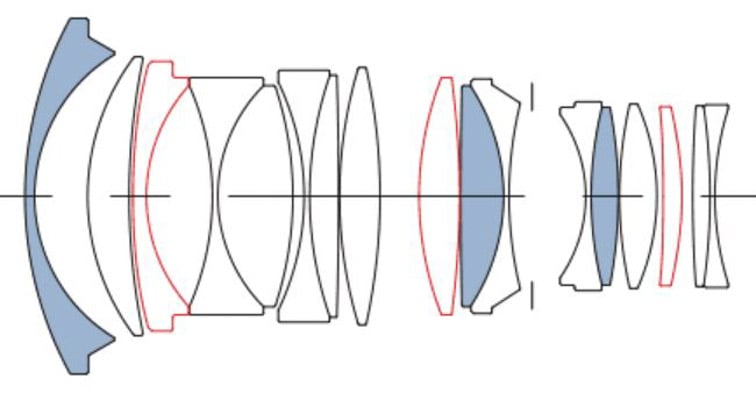
Closest focus distance is 0.29m (11.4in.) in manual focus resulting in a pretty useful magnification of 1:4.5. But due to the long lens the working distance is only 14cm (5.5in.) even when the lens hood is removed. A magnification of 1:10 is achieved at 0.46m distance. The Sony f1.4 and the Samyang reach a magnification of 1:5.3, the Sony f1.8 goes to 1:3.9. [+]
Filter-thread: 82mm. The Sony f1.8 needs much cheaper 55mm filters, the Sony f1.4 72mm, Samyang 67mm. [0]
Image stabilization: No optical stabilization of the lens. The Sony A7 Mark II bodies onward provide built-in sensor-shift stabilization. Same with the other lenses in this comparison. [0]
Auto focus: Built-in AF drive. Manual-focus override is by simply turning the focus ring. There is a focus hold button which can be assigned other tasks in the camera menu (same as the Sony f1.8). The focus ring has a linear gearing with an extremely long throw of 630 degrees (almost two full turns). I found the long throw a nuisance and not necessary even for an f1.2 lens which can indeed produce very shallow depth-of-field. It’s easy to see the single ticks when the stepper motor(s) move focus. And I think videographers will find it hard to quickly pull focus between background and foreground subjects. The Sony f1.8 also has linear gearing but with a more usable throw of 130 degrees. The other lenses have non-linear gearing which depends on the speed you turn the focus ring. As is usual with autofocus lenses for mirrorless systems all lenses in this comparison have no distance or dof markings. [+]
Covers full frame or smaller. Same with the competition. [+]
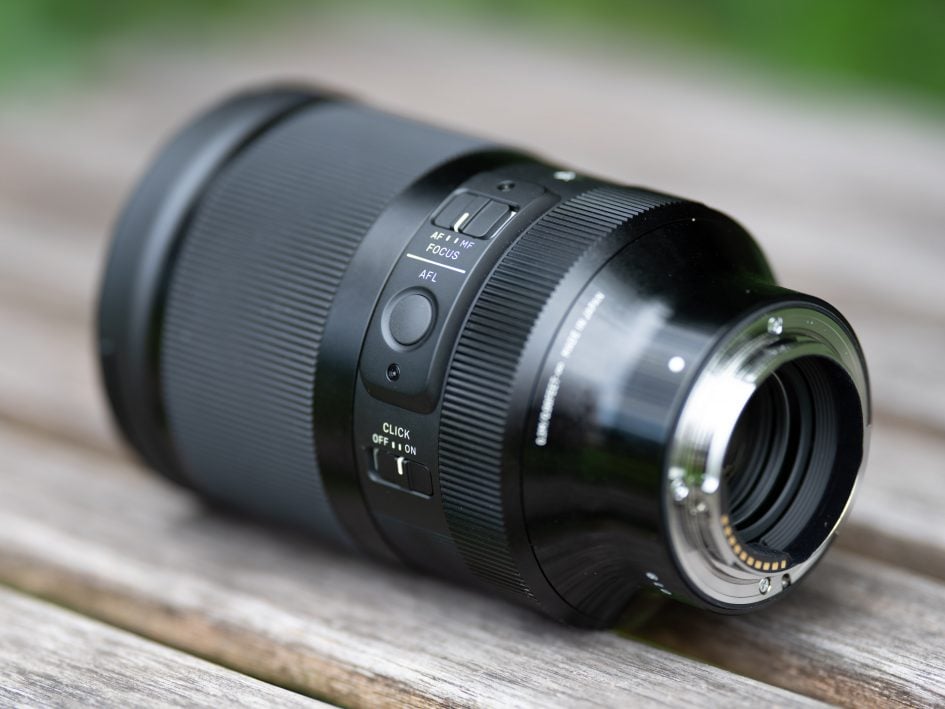
Price: The Sigma and the Sony f1.4 are the most expensive lenses in this comparison at 1500 EUR/USD. The Sony f1.8 sells for 700 EUR (incl. 19% VAT) / 750 USD while the Samyang is the least expensive at 530 EUR/USD. [0]
The Sigma 35mm f1.2 DG DN Art comes with a nice padded lens case plus strap, the lens hood is included, reversible for transport, and has a lock to prevent it from accidentally falling off. The Sony f1.4 and the Samyang come with a soft pouch, the Sony f1.8 comes without pouch. [+]
Sigma’s service can change the mount of the lens between Sony’s E-mount and L-mount (at a cost). This is a unique feature that no other manufacturer offers. [++]
Aperture ring: the Sigma 35mm f1.2 DG DN Art like the Sony FE 35mm f1.4 ZA has an aperture ring with 1/3 stop clicks which can be turned off for continuous, smooth, and noise-free operation. The other lenses in this comparison don’t have one. [+]
Sealing: The Sigma and the Sony lenses have thorough weather-sealing throughout the construction and on the lens mount.The Samyang is not specially sealed. [+]
The score of 2[-]/3[0]/9[+] shows that the Sigma 35mm f1.2 DG DN Art is quite well-featured with the unique option to get the lens-mount swapped. On the negative side are its huge size and weight.
Three wide-angle prime lenses
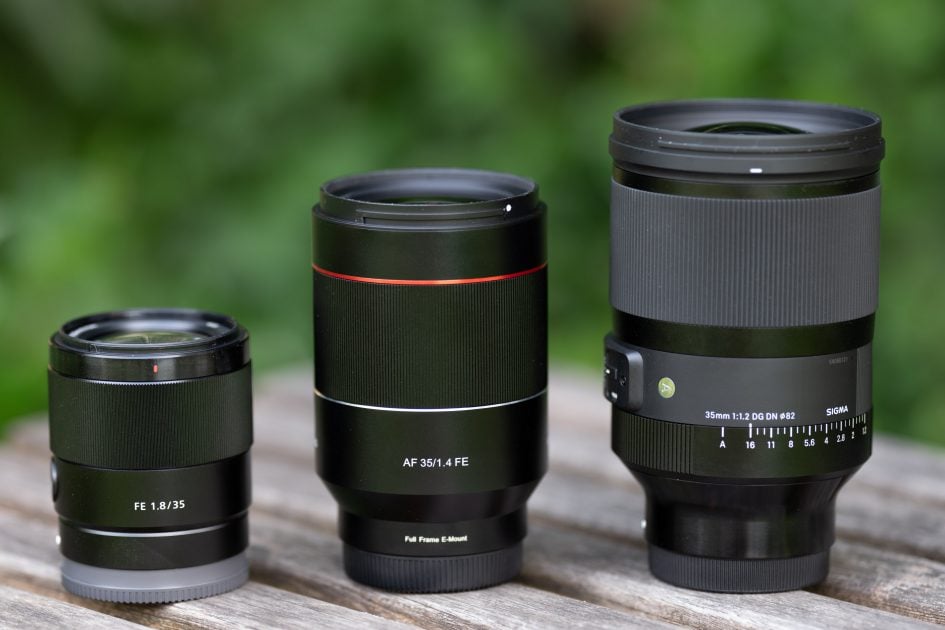
Above from left to right: Sony FE 35mm f1.8, Samyang AF 35mm f1.4 FE, Sigma 35mm f1.2 DG DN Art
Alternatives
If you want a 35mm E- or L-mount lens for a full-frame mirrorless camera with an f1.2 focal ratio then the new Sigma 35mm f1.2 DG DN Art is the only game in town. For alternatives you either have to choose a slower focal ratio, go manual focus, or make use of an adapter.
Here are the alternatives with autofocus but slower focal ratios:
- Sony has the FE 35mm f1.4 ZA from 2015 for 1500 EUR/USD and the FE 35mm f1.8 from 2019 for 700 EUR / 750 USD. Both can only be used on Sony E-mount cameras. See my Sony FE 35mm f1.4 ZA review which earned a Recommended and my Sony FE 35mm f1.8 review which came Highly Recommended.
- Samyang/Rokinon/Walimex has the AF 35mm f1.4 FE from 2017 for 530 EUR/USD. The lens is only available for E-mount. Check back soon for my complete Samyang AF 35mm f1.4 FE review.
- Sigma has the 35mm f1.4 Art, an older DSLR design from 2012 which can be had for 730 EUR / 700 USD. It’s 77 x 120mm in size, weighs 755g, and is available in E- and L-mount amongst others.
- Leica offers the APO-Summicron-SL 35mm f2.0 ASPH for 4400 EUR / 4600 USD. This lens is 73 x 102mm in size (w/o lens hood) and weighs 750g. It is only available in L-mount.
If you can do without autofocus there are some other options including three Samyang lenses (two geared for videographers), one Voigtländer, and a Zeiss Loxia:
- The Voigtländer Nokton 35mm 1.4 Classic E from 2017 is very small (67 x 40mm) and only 262g albeit its f1.4 focal ratio. Prices are around 700 EUR/USD. The aperture has to be controlled manually from the aperture ring of the lens. Full EXIF-data are transmitted, focus magnification and lens correction is enabled.
- Zeiss offers the Loxia 35mm f2.0 for E-mount from 2014 for 850 EUR / 1170 USD.
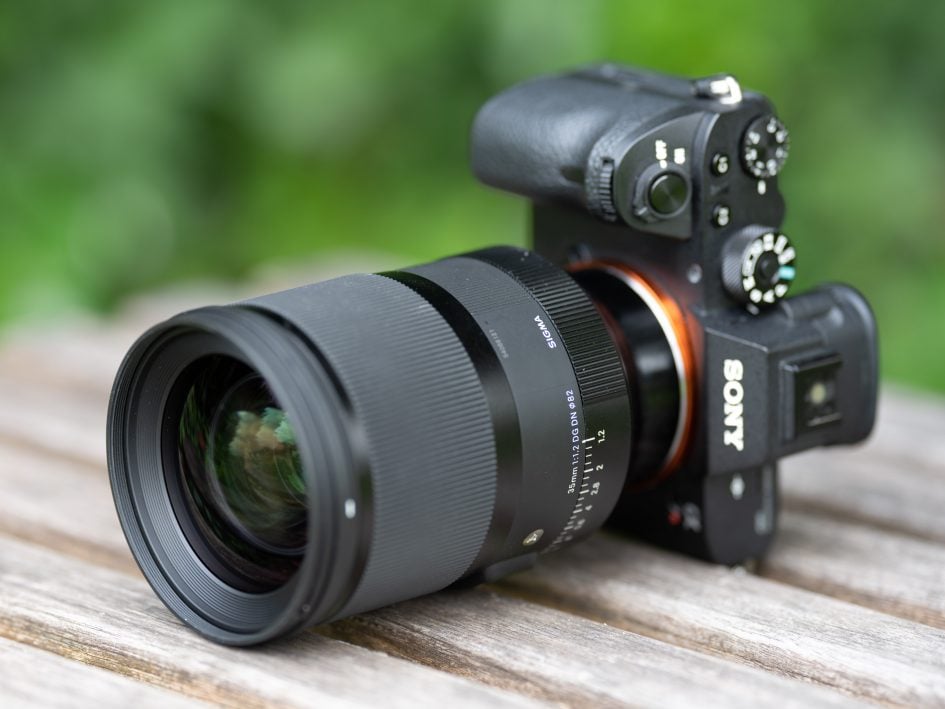
Focus
Focus accuracy and repeatability is critical to consistently produce sharp shots especially with large aperture lenses. Repeatability (the accuracy of focus on the same subject after repeated focus-acquisition) of this lens is very good (measured 98.5% in Reikan FoCal) with no outliers over a series of 40 shots. And there is very little focus variation whether the lens focuses from a closer distance or from infinity. In real-life shooting I had some occasions where autofocus did not find the target at f1.2. Strong contra-light seemed to be the cause – but other (slower) lenses had focused without problems in the same situation.
The lens focuses in around 0.8 sec on a Sony A7R II from infinity to 0.48m (1:10 magnification), which is a little slower than the Samyang and Sony FE 35mm f1.8 at 0.7 sec and the Sony FE 35mm f1.4 ZA at 0.5 sec. The rubberized focus ring is 40mm wide. This is the first lens for mirrorless cameras I have tested where the focus ring needs quite some force and is not easy to operate with one finger. This coupled with the strange 630 degrees throw from infinity to minimum focus distance at least has the benefit that you don’t easily de-focus the lens when touching the focus ring. All the other lenses have focus rings that can easily be operated with one finger.
AF-operation of the the Sigma Art and the Sony lenses is inaudible from the outside or if you record video with the built-in microphone. The Samyang produces a low ticking noise. As you pull focus, you’ll notice some focus breathing: the image of the Sigma 35mm f1.2 DG DN Art becomes 3% more magnified when I adjusted the focus from infinity to 0.48m. This is visible but hardly distracting when shooting videos. The Sony FE 35mm f1.4 ZA changes magnification by +6%, the Sony FE 35mm f1.8 and the Samyang by -1%.
Next check out my quality results!
Check prices on the Sigma 35mm f1.2 Art at B&H, Amazon, Adorama, WEX or Calumet.de. Alternatively get yourself a copy of my In Camera book or treat me to a coffee! Thanks!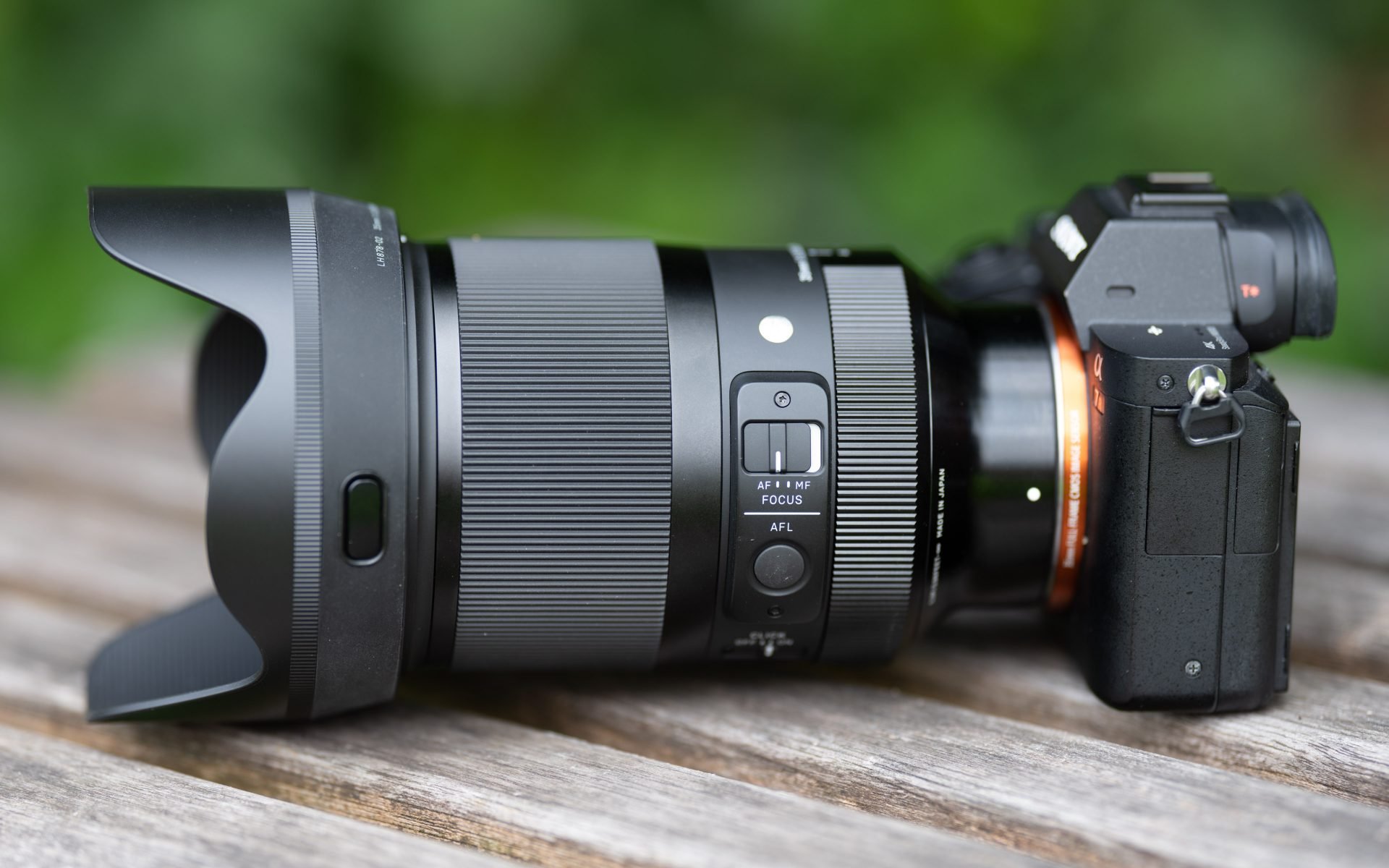
 The Sigma 35mm f1.2 Art is a mild wide-angle lens available in Sony FE and Leica L mounts, and boasts the largest focal ratio of any autofocus full-frame 35mm lens to date. That bodes well for a nice Bokeh - and the lens certainly delivered the goods in my tests: its Bokeh is probably as good as it gets on a 35mm lens. Add to that the light gathering power that is a half stop ahead of lenses with a focal ratio of f1.4 and an optical performance that is always a bit better and you have the best 35mm I've tested so far. Add in thorough weather sealing with fluorine coating on the front lens, a de-clickable aperture ring, the focus hold button, and a well padded lens case plus strap and you get a well-rounded package that should leave little open to wishes. Unfortunately it's also the largest and heaviest 35mm lens of the models I compared it against. But if you want the best 35mm lens for your full-frame Sony or L-mount mirrorless camera, the Sigma 35mm f1.2 DG DN Art is it. This also justifies its price and earns a Highly Recommended! Shame it's not available for other lens-mounts too.
The Sigma 35mm f1.2 Art is a mild wide-angle lens available in Sony FE and Leica L mounts, and boasts the largest focal ratio of any autofocus full-frame 35mm lens to date. That bodes well for a nice Bokeh - and the lens certainly delivered the goods in my tests: its Bokeh is probably as good as it gets on a 35mm lens. Add to that the light gathering power that is a half stop ahead of lenses with a focal ratio of f1.4 and an optical performance that is always a bit better and you have the best 35mm I've tested so far. Add in thorough weather sealing with fluorine coating on the front lens, a de-clickable aperture ring, the focus hold button, and a well padded lens case plus strap and you get a well-rounded package that should leave little open to wishes. Unfortunately it's also the largest and heaviest 35mm lens of the models I compared it against. But if you want the best 35mm lens for your full-frame Sony or L-mount mirrorless camera, the Sigma 35mm f1.2 DG DN Art is it. This also justifies its price and earns a Highly Recommended! Shame it's not available for other lens-mounts too.



